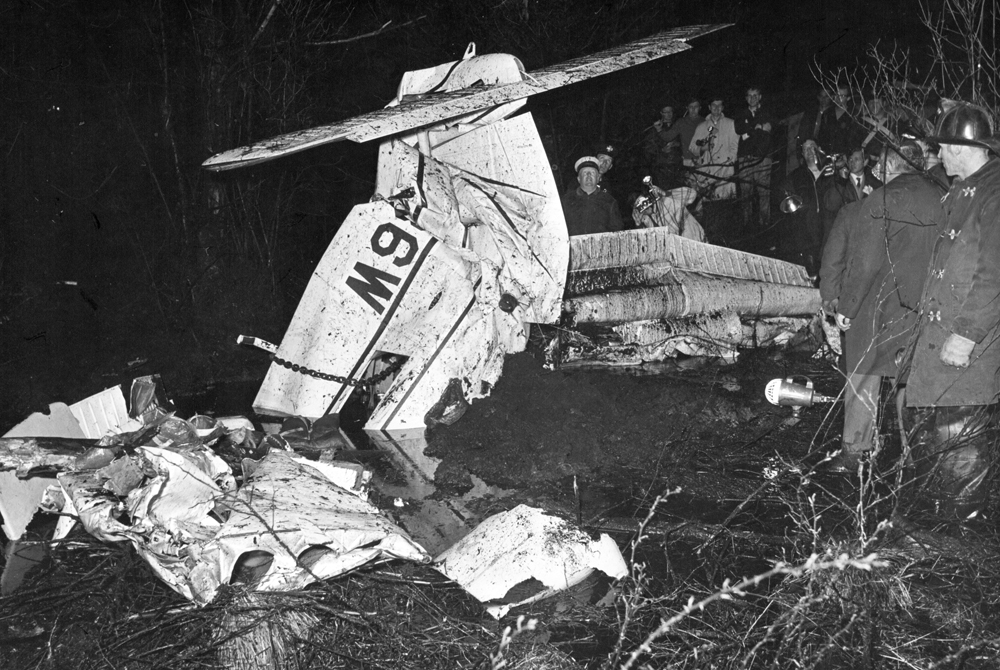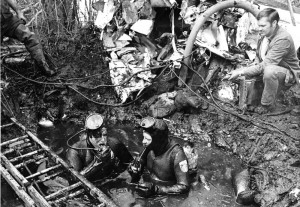True Tales Revisited: The Tragic Trio
By George T. Comeau
The wreckage of the Piper Cherokee as it was found that night near the Canton/Stoughton line (Collection of the Canton Historical Society)
This story originally appeared in the Canton Citizen on March 30, 2017 and was reprinted this week.
The weather in the Bahamas is quite beautiful this time of year, and for the members of the Skycombers Flying Club it would be a perfect way to spend a weekend away after a tough New England winter. In the early 1970s, amateur aviation had become well within the reach of many, and flying clubs offered easy access to training and equipment to allow just about anyone to take to the skies.
Midday on Sunday, April 19, 1970, three amateur aviators packed their bags and headed to the Mansfield Municipal Airport. They were all good friends and were led by their flying instructor, William Breakey, who was also a painting contractor from Needham. Breakey had arranged for his students to take a week’s vacation in the Caribbean and it would be a superb opportunity to try out their flying skills. Along on the trip was Elizabeth Wroblicka, a 47-year-old schoolteacher and mother of six from Franklin, and 21 year-old Jerrold Werdin from Holliston, who was just learning to become a pilot. The trio waited for a fourth club member, James Flynn from Stoughton, but he failed to arrive on time so they simply left without him. Flynn later explained that he “had to work.”
The plane, which was co-owned by Breakey and Wroblicka, was a Piper PA-32 and had been built in 1965. The 260-horsepower plane was known as a Cherokee Six, owing to the fact that it could take six passengers with a fairly decent flying range of just about 850 miles. FAA records indicate that the plane was issued a registration certificate on April 4, which may mean that the trip to the Bahamas only 12 days later was a maiden flight for the aircraft. The 1,200-mile trip would require the plane to land in North Carolina and Florida before the final destination in Nassau and the Bahamas.
The return to Mansfield would have taken the same route north, and they headed back on Friday, April 24. At a cruising speed of 126 mph, the small plane made its way up the East Coast and the pilot received a weather briefing up to Wilmington, North Carolina. There is no indication that they had landed in Wilmington or that they had been advised of the weather in New England. The flight may have taken anywhere between eight and 10 hours. Inside the small cabin, Breakey sat at the pilot’s seat as they passed over Norwood and made the turn over the Fowl Meadows and up the line of Route 138 towards Mansfield. The trio had had a long day, and the flight was likely very bumpy as they headed towards home.
It was a typical spring season, rain fell throughout the day, and the outside temperature hovered around 43 degrees. Almost half an inch of rain had fallen that day, and thick fog settled over the entire Neponset Valley. The plane had been equipped for the use of instruments to help guide the pilot, and the pilot seemed seasoned. Around 10:10 p.m. residents and passersby observed the low-flying plane. With steady gusts from the south of 15 mph, the small plane was buffeted. Residents of the area reported seeing the plane flying extremely low. Dennis Roche of Meyer Terrace told the Herald Traveler that he “was walking down the highway, 138, with some friends when we saw the lights of a plane flying real low.” Clearly the plane was in trouble, he said. “It circled over a sandpit and over a roof of a house and the last we saw it was going down into the swamp. We heard it crash, but didn’t see anything and couldn’t find it.”
Authorities were summoned immediately, and firefighters from Canton, Stoughton, Easton and Bridgewater all responded. More than 150 civil defense workers began to search the swamp as part of a massive effort to locate the downed plane. Residents had heard “whirring sounds” and several described hearing a “thump.” Yet it was foggy and the area where the plane went down was deep wetland thick with briars and mud.
For over an hour the searchers worked to find the plane. After midnight, the wreckage was discovered and it was clear that there would be no survivors. Firemen worked in vain until 1:30 a.m. to try to recover the bodies. The rescue search became a recovery mission that was slated to begin on Saturday morning at 7 a.m. Since the plane crashed along the Stoughton/Canton line, it was decided that in fact the wreckage was in Stoughton and the Civil Defense Director and Chief John Donahue managed the recovery operation. In fact, the crash site was only 100 yards or so into Stoughton — behind a house at 20 Washington Street. The searchers found about 15 feet of tail section from the 33-foot-long plane slammed into deep black mud.
High overhead by helicopter, Marine Colonel W.P. Anderson from the South Weymouth Naval Air Base surveyed the crash site and came to the conclusion that the plane hit a tree about a quarter of a mile from the crash site; trying in vain to pull up from the low altitude caused the plane to stall and spiral into the swamp at an extremely high rate of speed. The theory of the plane crash was such that it was listed as an “uncontrolled collision with the ground” and that spatial disorientation coupled with improper in-flight decisions or planning led to the crash. The pilot, while trying to avoid the wind, may well have become disoriented in the dark and had no idea how low he was flying. The result is sometimes known as the “death spiral” and reaction time can be mere seconds before catastrophe.

Walter Kessler (right) and Donald O’Shea (left) inside the crash site prior to recovering the first two victims (Collection of the Canton Historical Society)
Canton had established a new unit to handle emergencies that arose in and around the waters of the town. The Canton Underwater Rescue Unit was comprised of para-professional volunteers with scuba diving experience. There were more than 13 men in the unit, which included firefighters and civil defense experts to support the dive team of four men or so. That spring, the Underwater Rescue Team had trained in the town’s ponds and lakes to map the underwater terrain in preparation for rescue efforts should they become needed.
The recovery mission for the Canton Fire Dive Team was perhaps the most daunting and dangerous event at the time. The plane had literally impaled itself into more than 10 feet of muck and mud. To make matters even worse, large quantities of aviation fuel soaked the site. With zero visibility the divers said that they had “to fight the psychological feeling of being suffocated by the mud.” What’s more, any attempt to lower the swamp level failed and the divers stood “breast deep in the slime.” Ladders were brought in to span the mud-filled crater at the impact site. Pumps worked with little effect to suck the mud from the crash.
By 2 p.m. the next day all three bodies had been recovered. Most sorrowfully of all was the moment when Wroblicka’s straw hat floated to the surface. Polaroid snapshots from the trip littered the mud alongside travel brochures and bits of luggage. The twisted remains of the young man with cuffed jeans and sneakers barely resembling the lost youth was covered in plastic to shield him from the more than 200 onlookers who had gathered to watch the grim scene.
There are hardly ever heroes in such a tragedy, but it was the work of Donald O’Shea, a civil defense diver, alongside firefighter Walter Kessler, who worked for over three hours in the most dangerous conditions to bring closure to the families of the victims. The fuel caused skin irritation, forcing the two to abandon their work. James O’Neill and William McIntyre worked for three more hours to recover the last body. And as the recovery efforts ended, a slight man in a baseball cap and quilted vest looked on. It was James Flynn, who failed to go on the ill-fated trip. Flynn stood by the wreckage, less than two and a half miles from his home in Stoughton and simply shook his head. Sadness flowed over him, and he walked away quietly, slipping into the crowd.
Special thanks to Willard Thorn for his insights into the crash. Peace to the families affected by this tragedy 53 years ago this week.
Short URL: https://www.thecantoncitizen.com/?p=109215










